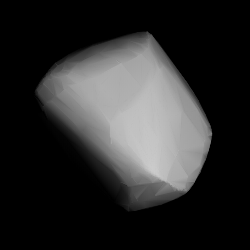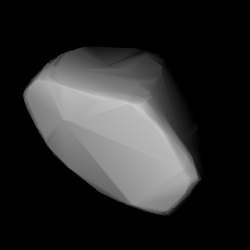1024 Hale, provisional designation A923 YO13, is a carbonaceous background asteroid from the outer regions of the asteroid belt, approximately 45 kilometers (28 miles) in diameter. The asteroid was discovered on 2 December 1923, by Belgian–American astronomer George Van Biesbroeck at the Yerkes Observatory in Wisconsin, United States. It was named for American astronomer George Ellery Hale. The dark C-type asteroid may have a rotation period of 16 hours.
6433 Enya, provisional designation 1978 WC, is a stony background asteroid from the inner regions of the asteroid belt, approximately 7 kilometers in diameter. It was discovered on 18 November 1978, by Czech astronomer Antonín Mrkos at the Kleť Observatory in the Czech Republic. It was named for Irish musician Enya.

1117 Reginita is a stony background asteroid from the inner regions of the asteroid belt. It was discovered on 24 May 1927, by Catalan astronomer Josep Comas i Solà at the Fabra Observatory in Barcelona, Spain, who named it after his niece. The bright S-type asteroid has a notably short rotation period of 2.9 hours and measures approximately 10 kilometers in diameter.
1156 Kira, provisional designation 1928 DA, is a stony background asteroid from the inner regions of the asteroid belt, approximately 9 kilometers in diameter. It was discovered on 22 February 1928, by German astronomer Karl Reinmuth at Heidelberg Observatory in southwest Germany. Any reference of its name to a person or occurrence is unknown.
6537 Adamovich, provisional designation 1979 QK6, is a stony Florian asteroid from the inner regions of the asteroid belt, approximately 4 kilometers in diameter.
11277 Ballard (provisional designation 1988 TW2) is a Phocaea asteroid from the inner regions of the asteroid belt, approximately 6.3 kilometers (3.9 miles) in diameter. It was discovered on 8 October 1988, by American astronomer couple Carolyn and Eugene Shoemaker at the Palomar Observatory in California. The assumed S-type asteroid has a rotation period of at least 10 hours. It was named for American marine scientist Robert Ballard.
1651 Behrens, provisional designation 1936 HD, is a stony Florian asteroid from the inner regions of the asteroid belt, approximately 10 kilometers in diameter. Discovered by Marguerite Laugier in 1936, it was named after Johann Behrens.
1215 Boyer, provisional designation 1932 BA, is a stony Eunomian asteroid from the central region of the asteroid belt, approximately 20 kilometers in diameter. It was discovered by astronomer Alfred Schmitt in 1932, who named it after French astronomer and college Louis Boyer.

2708 Burns is a carbonaceous Themistian asteroid from the outer regions of the asteroid belt, approximately 19 kilometers in diameter. It was discovered on 24 November 1981, by American astronomer Edward Bowell at the Anderson Mesa Station near Flagstaff, Arizona, in the United States. It was named after American planetary scientist Joseph A. Burns. The likely elongated B-type asteroid has a rotation period of 5.3 hours.
1295 Deflotte, provisional designation 1933 WD, is a carbonaceous asteroid from the outer regions of the asteroid belt, approximately 48 kilometers in diameter. It was discovered on 25 November 1933, by French astronomer Louis Boyer at the Algiers Observatory in Algeria, North Africa. The asteroid was named after the discoverer's nephew.
1253 Frisia, provisional designation 1931 TV1, is a carbonaceous Themistian asteroid from the outer regions of the asteroid belt, approximately 20 kilometers in diameter. Discovered by Karl Reinmuth at Heidelberg Observatory in 1931, the asteroid was later named after the region of Frisia and the Frisian Islands.
2571 Geisei, provisional designation 1981 UC, is a stony Florian asteroid from the inner regions of the asteroid belt, approximately 6 kilometers in diameter. It was discovered by Japanese astronomer Tsutomu Seki at Geisei Observatory on 23 October 1981, and named for the Japanese village of Geisei.
1271 Isergina, provisional designation 1931 TN, is a carbonaceous background asteroid from the outer regions of the asteroid belt, approximately 45 kilometers in diameter. It was discovered on 10 October 1931, by Soviet astronomer Grigory Neujmin at the Simeiz Observatory on the Crimean peninsula. The asteroid was named after Crimean physician and friend of the discoverer, Pyotr Isergin.
1190 Pelagia, provisional designation 1930 SL, is a dark Nysian asteroid from the inner regions of the asteroid belt, approximately 17 kilometers in diameter. It was discovered on 20 September 1930, by Soviet–Georgian astronomer Grigory Neujmin at the Simeiz Observatory on the Crimean peninsula. The asteroid was named after astronomer Pelageya Shajn.

1197 Rhodesia, provisional designation 1931 LD, is a dark background asteroid from the outer regions of the asteroid belt, approximately 48 kilometers in diameter. It was discovered on 9 June 1931, by South African astronomer Cyril Jackson at the Union Observatory in Johannesburg. The likely C-type asteroid has a rotation period of 16.1 hours. It was named for Rhodesia, a former British colony and unrecognised state, which is now Zimbabwe.
1306 Scythia, provisional designation 1930 OB, is a dark Ursula asteroid from the outer regions of the asteroid belt, approximately 72 kilometers in diameter. It was discovered on 22 July 1930, by Soviet astronomer Grigory Neujmin at the Simeiz Observatory on the Crimean peninsula. The asteroid was named for the historic region of Scythia.
6229 Tursachan, provisional designation 1983 VN7, is a Themistian asteroid from the outer regions of the asteroid belt, approximately 10 kilometers (6 miles) in diameter. It was discovered on 4 November 1983, by American astronomer Brian Skiff at Lowell's Anderson Mesa Station near Flagstaff, Arizona, in the United States. The presumed C-type asteroid has a rotation period of 16.6 hours and is possibly elongated. It was named after a Gaelic word meaning "Standing Stones".
7548 Engström, provisional designation 1980 FW2, is dark Themistian asteroid from the outer region of the asteroid belt, approximately 9 kilometers in diameter. It was discovered on 16 March 1980, by Swedish astronomer Claes-Ingvar Lagerkvist at ESO's La Silla Observatory site in northern Chile. The asteroid was later named after Swedish artist Albert Engström.
1257 Móra, provisional designation 1932 PE, is an asteroid from the inner regions of the asteroid belt, approximately 15 kilometers in diameter. It was discovered on 8 August 1932, by German astronomer Karl Reinmuth at Heidelberg Observatory in southwest Germany. The asteroid was named after Hungarian astronomer Károly Móra.
1724 Vladimir, provisional designation 1932 DC, is a rare-type asteroid from the central region of the asteroid belt, approximately 35 kilometers in diameter. It was discovered on 28 February 1932, by Belgian astronomer Eugène Delporte at the Royal Observatory of Belgium in Uccle, Belgium. The asteroid was later named by astronomer Milorad Protić after his grandson, Vladimir.



